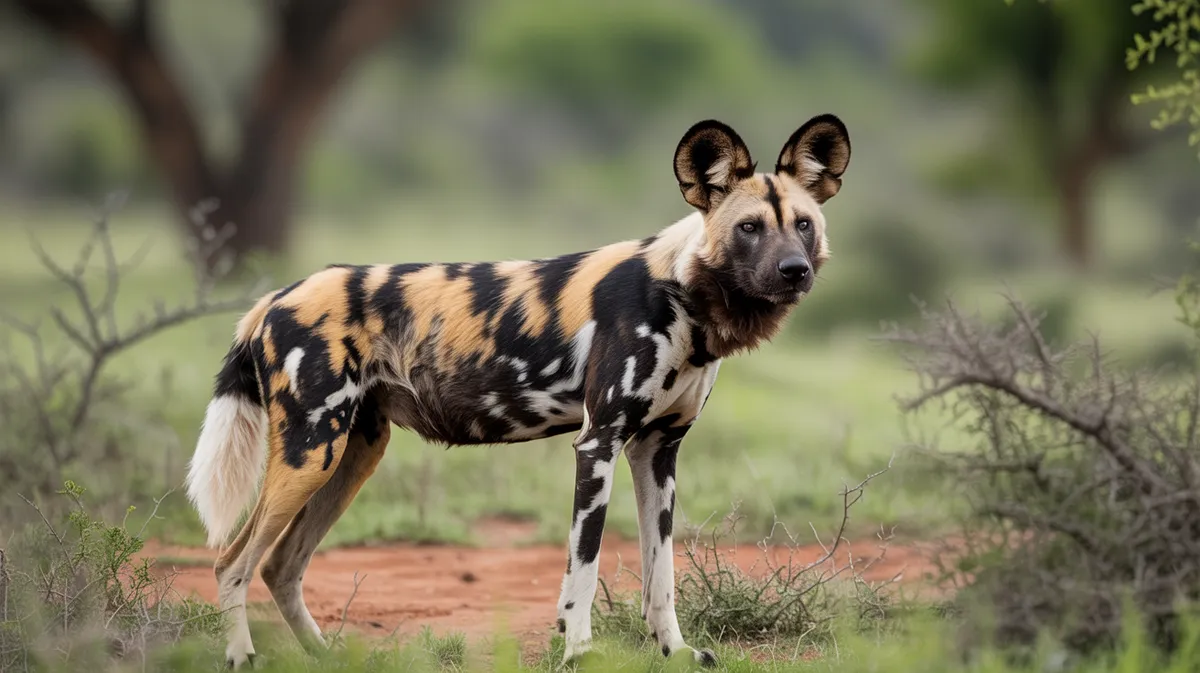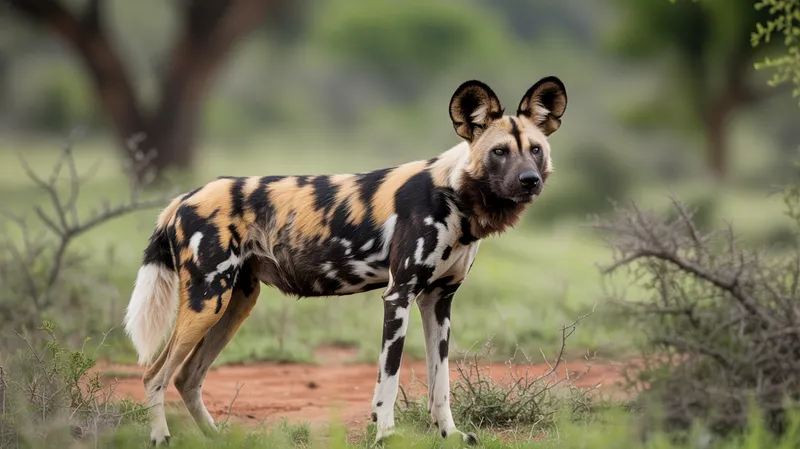
African Wild Dog
Lycaon pictus

Meet the African Wild Dog
The African Wild Dog, also known as the painted wolf or Cape hunting dog, is a highly social and intelligent carnivorous mammal native to sub-Saharan Africa. It is easily recognized by its mottled fur, large rounded ears, and long legs, which help it cover vast distances while hunting. Living in packs of up to 30 individuals, these dogs have a complex social hierarchy and are renowned for their cooperative hunting strategies, achieving some of the highest hunting success rates among African predators. Sadly, their populations have drastically declined due to habitat loss, human conflict, and disease, making them one of Africa's most endangered large carnivores.
Classification
Mammal
Habitat
Savanna, grassland, and open woodland
Diet
Carnivore
Lifespan
10-12 years in the wild
Conservation
Endangered
Weight
18-36 kg (40-79 lbs)
📖Fascinating Facts
Unique Coats
Each African Wild Dog has a distinct coat pattern of black, white, brown, and yellow, making individuals easily identifiable.
Teamwork Hunters
African Wild Dogs hunt cooperatively in tightly-coordinated packs, allowing them to bring down prey much larger than themselves.
Large Ears
Their prominent rounded ears help with excellent hearing and act as heat dissipators in the hot African climate.
📋Detailed Description
The African wild dog (Lycaon pictus) is a medium-to-large canid, with adults typically weighing between 18 and 36 kg (40–79 lbs) and standing about 60 to 75 cm (24–30 in) at the shoulder. Its coat is uniquely patterned with irregular patches of black, brown, yellow, and white, providing effective camouflage in dappled savanna environments. Unlike other canids, the African wild dog has only four toes per foot and lacks dewclaws, a trait unique within the family Canidae. Its large, rounded ears enhance auditory acuity and aid in thermoregulation. The species is highly social, living in cohesive packs that can range from 2 to over 30 individuals, though most commonly 6–20. Packs are led by a dominant breeding pair, with a strict social hierarchy and cooperative care of young. African wild dogs are obligate hypercarnivores, with dentition specialized for shearing flesh, and they rely on endurance running to pursue prey over long distances, often exceeding 5 km (3 mi) in a single hunt. Their vocal repertoire includes twittering, hoots, and a distinctive 'hoo' call used for long-distance communication. The species is diurnal, with peak activity during early morning and late afternoon. African wild dogs play a critical ecological role as apex predators, influencing prey populations and ecosystem dynamics.
💡 Did you know?
An African Wild Dog pack can coordinate to chase prey over distances of several kilometers, with success rates exceeding 80%—one of the highest among large carnivores.
🔬Research & Sources
Wikipedia Summary
The African wild dog, also called painted dog and Cape hunting dog, is a wild canine native to sub-Saharan Africa. It is the largest wild canine in Africa, and the only extant member of the genus Lycaon, which is distinguished from Canis by dentition highly specialised for a hypercarnivorous diet and by a lack of dewclaws.
Last Modified: 5/29/2025
🎭Behavior & Social Structure
African wild dogs exhibit complex cooperative behaviors, particularly during hunting and pup-rearing. They hunt primarily medium-sized ungulates such as impala, gazelles, and wildebeest calves, employing coordinated group tactics that involve strategic positioning and high-speed chases reaching up to 66 km/h (41 mph). Their hunts are among the most successful of any large carnivore, with success rates often exceeding 70%. After a kill, food is regurgitated for pups and subordinate pack members. Social bonds are reinforced through frequent physical contact, muzzle-licking, and communal resting. Packs maintain large territories, sometimes exceeding 1,500 km² (580 sq mi), which they patrol and scent-mark. Intra-pack aggression is rare, with conflict resolution often achieved through submissive gestures. Daily routines include group greeting ceremonies, cooperative care of young, and communal denning during the breeding season.
👶Reproduction & Life Cycle
Breeding is typically restricted to the dominant (alpha) pair within a pack, with subordinate females rarely reproducing. Mating occurs once a year, usually during the dry season (March–June in southern Africa). After a gestation period of about 69–73 days, the alpha female gives birth to a litter of 2–21 pups (average 10), the largest among canids. Pups are born in a den, often an abandoned aardvark or warthog burrow, where they remain for the first 8–10 weeks. All pack members participate in feeding and protecting the pups, regurgitating food and guarding the den. Weaning begins at 5 weeks, and pups start to accompany adults on hunts at around 3 months. High pup mortality is common, with survival closely linked to pack size and stability.
🛡️Adaptations & Survival
African wild dogs have evolved several adaptations for endurance hunting and social living. Their long limbs and lean bodies are optimized for sustained high-speed chases, while their large lungs and heart support aerobic activity. The unique dentition—reduced molars and enlarged carnassials—facilitates rapid meat processing. Their large, bat-like ears dissipate heat and detect distant sounds, aiding in both hunting and social communication. Behavioral adaptations include complex vocalizations for coordination, cooperative hunting strategies, and an altruistic social system where injured or sick individuals are cared for by the pack. Their mottled coat provides camouflage in variable light conditions, and their lack of dewclaws reduces the risk of injury during long pursuits.
🎨Cultural Significance
African wild dogs have a mixed reputation in African folklore and local cultures. In some regions, they are admired for their hunting prowess and social cohesion, symbolizing teamwork and unity. In others, they are viewed negatively due to livestock predation and are sometimes associated with bad omens or misfortune. Unlike lions or leopards, they have not featured prominently in traditional art or mythology, but modern conservation campaigns increasingly use their charismatic image to promote wildlife protection and ecotourism.
🔬Recent Research & Discoveries
Recent research has focused on the genetic diversity of fragmented populations, revealing concerning levels of inbreeding in some regions. Studies on disease ecology have highlighted the vulnerability of wild dogs to pathogens from domestic dogs, prompting vaccination campaigns in buffer zones. GPS collaring and remote sensing have improved understanding of their spatial ecology, showing that protected areas alone are often insufficient for their conservation. Behavioral studies continue to explore the mechanisms of cooperation, altruism, and communication within packs. Ongoing reintroduction and metapopulation management projects in southern Africa are testing new models for large carnivore conservation.
🎥Wildlife Videos

Killer Caretakers: Painted Dogs | World's Deadliest
Painted dogs are ruthless killers when they team up against large prey. But they show surprising compassion at home, sharing ...
Nat Geo Animals

Did You Know African Wild Dogs Eat Their Prey Alive?
Unlike lions, which secure their prey by killing it before eating, African Wild Dogs display a much more hurried and chaotic ...
Wild Africa Adventure Films

Attempting to Film African Wild Dogs in the Flooded Okavango
African wild dogs proved to be one of the toughest species to film. Please LIKE and SUBSCRIBE if you enjoyed it!
Nature on PBS

The Bush Dog Is So Rare They Thought It Was Extinct
This is the smallest and derpiest dog you've likely never heard of. Become an Animalogic member: ...
Animalogic

National Geographic Documentary African Wild dog Wildlife Animal
National Geographic Documentary Aprican Animas #documentaries #natgeowild #netflix #netflix #animalsvideo #bbc #realwild ...
Animals Videos Populer

Lion vs Wild Dog: Look How This Lion Ended These Dogs | Animal Fighting
Lion vs Wild Dog: Look How This Lion Ended These Dogs | Animal Fighting Witness an intense clash between a powerful lion and ...
VWildlife
🌍Habitat Information
The African Wild Dog typically inhabits Savanna, grassland, and open woodland environments. African Wild Dogs have adapted to their environments with specialized features and behaviors.
Primary Habitat:
Savanna, grassland, and open woodland
More detailed habitat information will be available soon.
🛡️Conservation Status
The African Wild Dog is currently classified as Endangered. Conservation efforts are crucial for preserving this species for future generations.
Common Threats:
- 🏠Habitat loss and fragmentation
- 🌡️Climate change impacts
- 🎯Hunting and poaching
- 🏭Human-wildlife conflict
⚠️Threats & Conservation Challenges
African wild dogs face severe threats from habitat fragmentation, human-wildlife conflict, infectious diseases (notably canine distemper and rabies), and direct persecution. Their wide-ranging habits make them particularly vulnerable to habitat loss and fragmentation, as they require large, contiguous territories to sustain viable populations. Road mortality, snaring, and retaliatory killings by livestock farmers further reduce numbers. Disease outbreaks, often transmitted from domestic dogs, can decimate entire packs. As of 2024, the global population is estimated at fewer than 6,000 individuals, with fewer than 1,400 mature adults, and populations are highly fragmented. Conservation efforts are challenged by the need for landscape-scale management and community engagement.
🔬Scientific Classification
Scientific Name
Lycaon pictus
Classification Hierarchy
🔍 About Taxonomic Classification
Taxonomic classification is a hierarchical system used by scientists to classify and organize living organisms based on shared characteristics and evolutionary relationships.
The system moves from broad categories (Kingdom) to increasingly specific ones, with each animal's scientific name typically consisting of its Genus and species.
📝Community Notes
Share your observations and insights about the African Wild Dog with our community of wildlife enthusiasts.
Join Our Community
Sign in to share your observations and connect with fellow wildlife enthusiasts.
Sign In to ContributeNo community notes yet
Be the first to share your observations about the African Wild Dog!
Explore African Wild Dog
Select a tab above to learn more about this amazing animal.
📸Photo Gallery
No photos available for this animal yet.
🌟Discover More Wildlife
Continue your journey of discovery with more fascinating animals from our database
